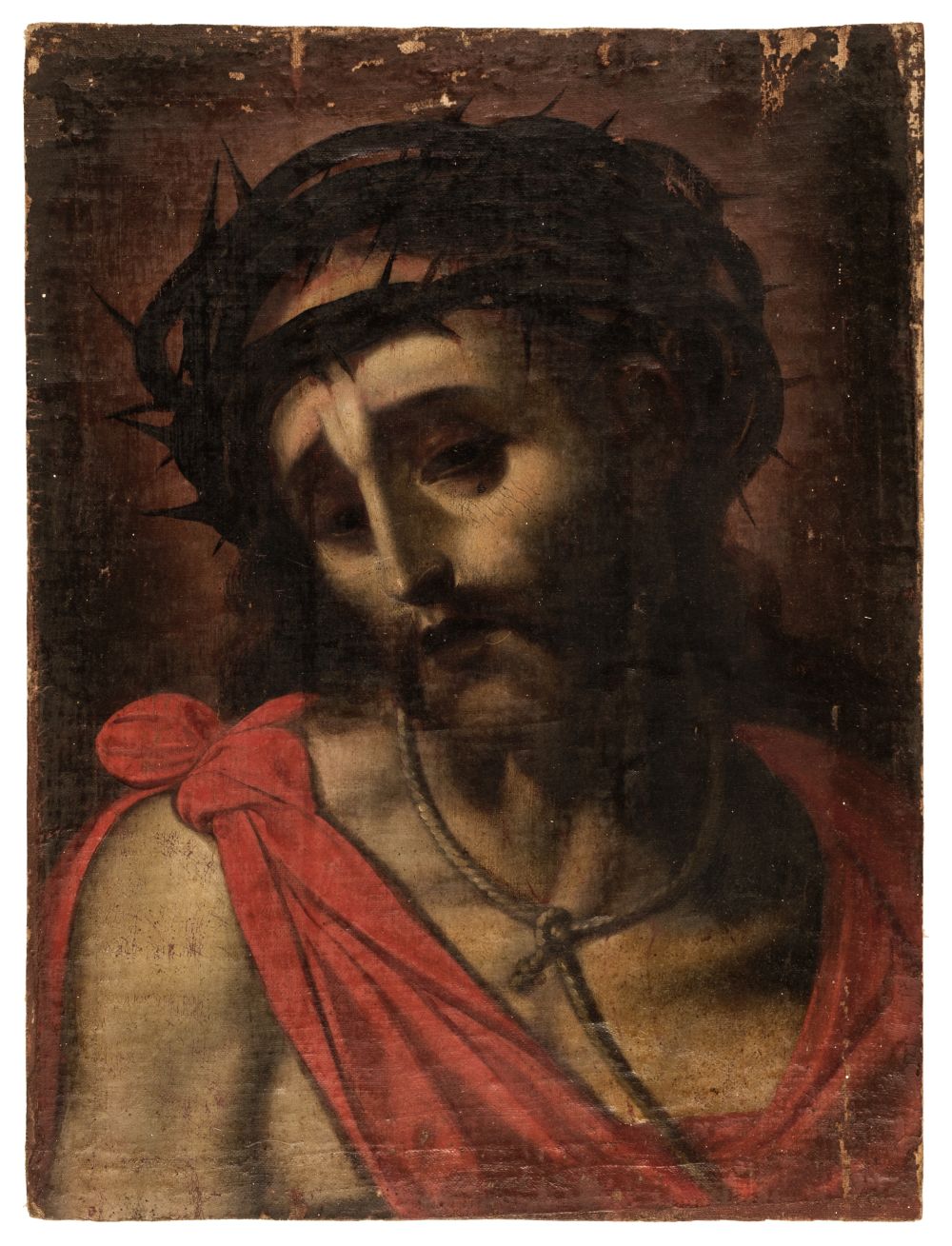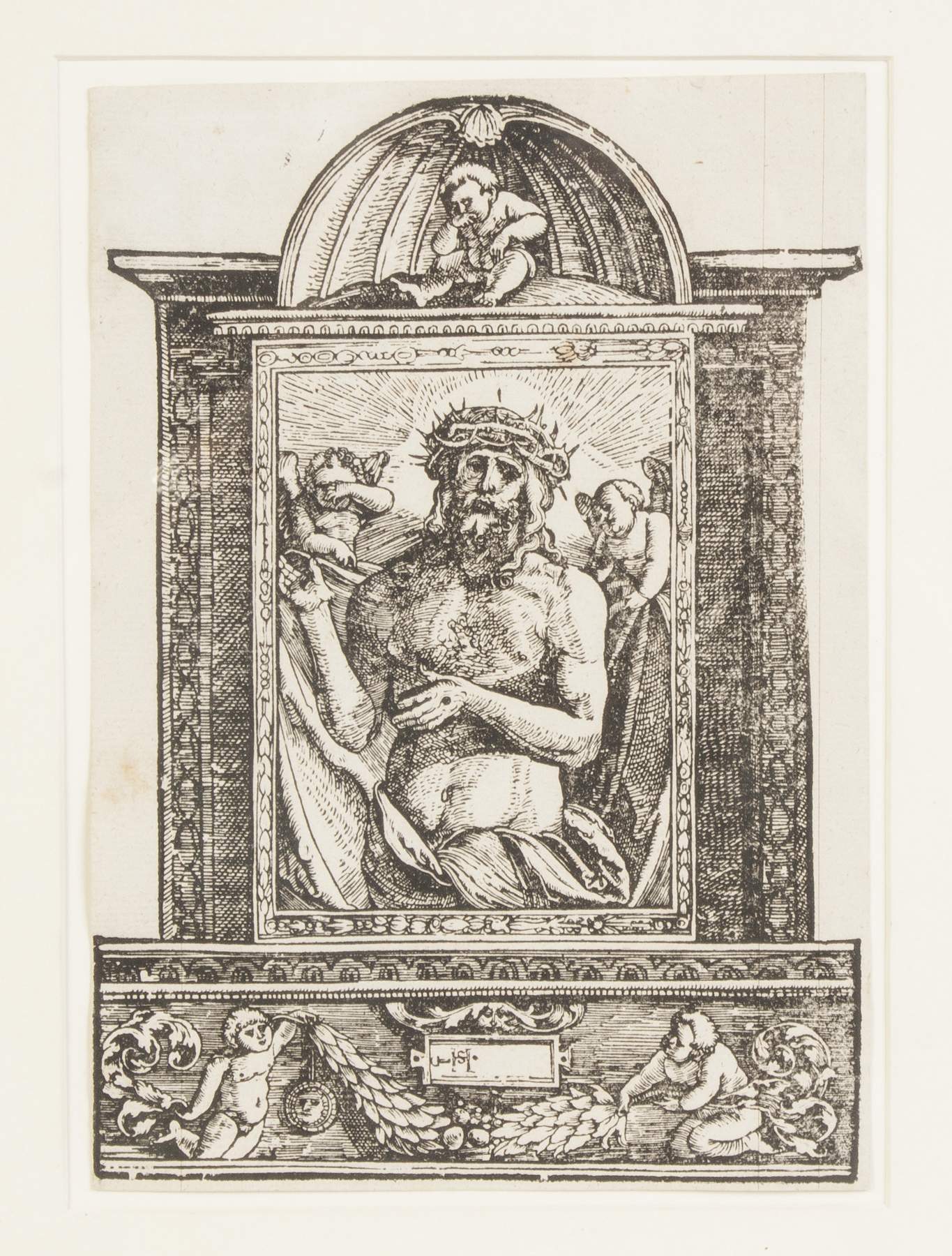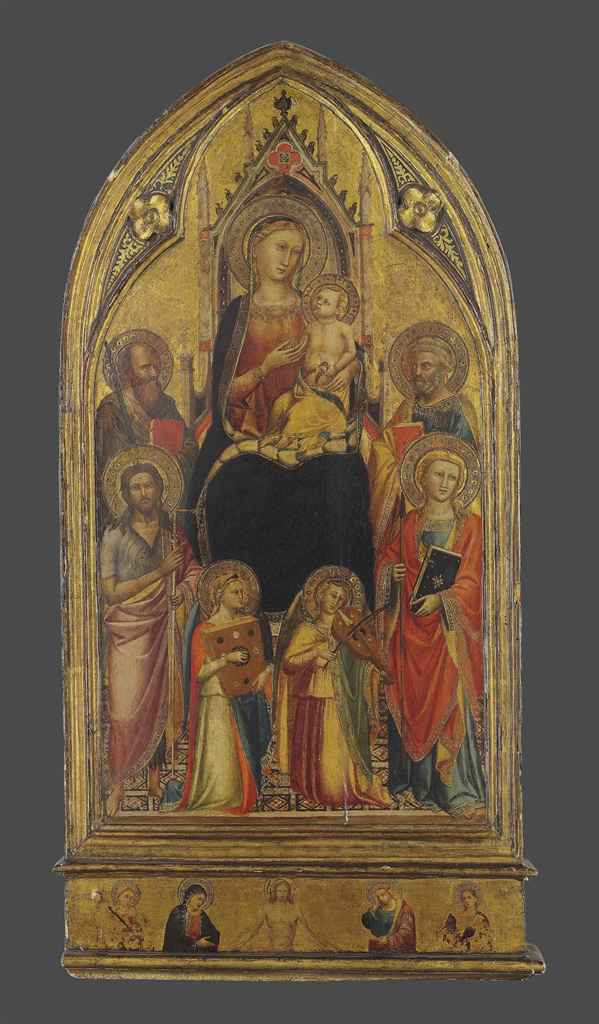CHRIST AS THE MAN OF SORROWS, full-page miniature from an ILLUMINATED MANUSCRIPT ON VELLUM
CHRIST AS THE MAN OF SORROWS, full-page miniature from an ILLUMINATED MANUSCRIPT ON VELLUM [Bohemia, c. 1420] 209 x 150mm. Christ stands on the tomb displaying his wounds and surrounded by the Instruments of His Passion, all within a full border with coats of arms at the lower corners (pigment losses from creasing particularly affecting the frame and background, very slight smudging to Christ's right hand and the hat and face of spitting man), later inscription on reverse. Provenance: Albert Figdor (1843-1927), of Vienna: his sale, H. Ball and P. Graupe, Eine Weiner Sammlung , Berlin, 12 May 1930, lot 6; Kurt Arnhold (1887-1951), of Dresden. Christ as the Man of Sorrows was one of the most popular devotional images in northern Europe during the Middle Ages and was produced in a variety of artistic media. From the mid-14th century the image was indulgenced and reciting prayers while contemplating it gained remission from thousands of years in Purgatory. The present miniature probably faced appropriate prayers in a private devotional manuscript, perhaps a Book of Hours. It shows characteristic qualities of Bohemian illumination as it developed at the time of King Wenceslas IV (r.1363-1400; d.1419), which saw Prague emerge as an important centre for the production of luxury manuscripts. The trompe l'oeil frame border of pale green decorated with yellow tracery recalls the framing of miniatures in the bibliophile king's sumptuous Bible (c.1390-95; Vienna, ÖNB, Cods 2759-64; see J. Krása, Die Handschriften König Wenzels IV , 1971, passim and pls XXIX, 125 and 176). Similarly the elongated and softly modelled figure of Christ and the elaborate cascading folds of the drapery of his loincloth, which is identical to that on the figure of the crucified Christ in the Cibulka Triptych (Historisches Museum der Stadt Wien, Gotik: Prag um 1400: der Schöne Stil böhmische Malerei und Plastik in der Gotik , 1990, nos 56 and 4 respectively) show the influence of the 'Beautiful Style' which was introduced into Bohemian panel painting in the late 14th century by the Masters of the Trebon Altarpiece and Jeren Epitaph (G. Schmidt, 'The Beautiful Style', in B. Drake Boehm and J. Fajt, eds, Prague: the Crown of Bohemia, 1347-1437, 2006, pp.105-11). The reverse is blank, apart from a 16th-century inscription in Latin which translates 'In the year 1524 on the feast of St Mary Magdalene [22 July], master Jan Mraxi said to me at table that it has been prophesied to the dukes of Münsterberg that they will be reduced to such poverty that a mule could carry off the substance of all of them, but that good fortune will come back amongst them, so that they will return to their original wealth'. Jan Mraxi was an ambassador of Archduke Ferdinand I (1503-1564; Holy Roman Emperor from 1558). After King Louis II (r.1516-1526) of Hungary and Bohemia was slain by Sultan Suleiman the Magnificent at the Battle of Mohàcs in 1526, Mraxi was sent to the court of King Sigismund I of Poland in Krakow to stake Ferdinand's claim to the crowns of his deceased brother-in-law (S. von Herberstein, Moscovia der Haupstat in reissen durch S. Freyhern zu Herberstainzusamen getragen , 1557, p.663 and F. von Adelung, Siegmund Freiherr von Herberstein, mit besonderer Rücksicht auf seine Reisen in Rußland , 1818, pp.134, 211). In 1524 the duke of Münsterberg, in Silesia (now Ziebice, Poland), was Charles I of Podebrady (1498-1536), son of Henry the Older, duke of Oels and count of Kladsko. The arms on the lower left and right of the miniature are those of Charles's ancestors and founders of the noble Bohemian House of Podebrady, Victor, Lord of Kunstát and Podebrady (1403-1427) and Anne of Wartenberg, respectively (J. Louda and M. Maclagan, Lines of Succession: Heraldry of the Royal Families of Europe , 1981, p.171, table 87 and J. Carek, Mestské znaky v ceskych zemich , 1985, pp.299-300). The miniature probably dates from the early years of their marriage. The artist erroneously depict
CHRIST AS THE MAN OF SORROWS, full-page miniature from an ILLUMINATED MANUSCRIPT ON VELLUM
CHRIST AS THE MAN OF SORROWS, full-page miniature from an ILLUMINATED MANUSCRIPT ON VELLUM [Bohemia, c. 1420] 209 x 150mm. Christ stands on the tomb displaying his wounds and surrounded by the Instruments of His Passion, all within a full border with coats of arms at the lower corners (pigment losses from creasing particularly affecting the frame and background, very slight smudging to Christ's right hand and the hat and face of spitting man), later inscription on reverse. Provenance: Albert Figdor (1843-1927), of Vienna: his sale, H. Ball and P. Graupe, Eine Weiner Sammlung , Berlin, 12 May 1930, lot 6; Kurt Arnhold (1887-1951), of Dresden. Christ as the Man of Sorrows was one of the most popular devotional images in northern Europe during the Middle Ages and was produced in a variety of artistic media. From the mid-14th century the image was indulgenced and reciting prayers while contemplating it gained remission from thousands of years in Purgatory. The present miniature probably faced appropriate prayers in a private devotional manuscript, perhaps a Book of Hours. It shows characteristic qualities of Bohemian illumination as it developed at the time of King Wenceslas IV (r.1363-1400; d.1419), which saw Prague emerge as an important centre for the production of luxury manuscripts. The trompe l'oeil frame border of pale green decorated with yellow tracery recalls the framing of miniatures in the bibliophile king's sumptuous Bible (c.1390-95; Vienna, ÖNB, Cods 2759-64; see J. Krása, Die Handschriften König Wenzels IV , 1971, passim and pls XXIX, 125 and 176). Similarly the elongated and softly modelled figure of Christ and the elaborate cascading folds of the drapery of his loincloth, which is identical to that on the figure of the crucified Christ in the Cibulka Triptych (Historisches Museum der Stadt Wien, Gotik: Prag um 1400: der Schöne Stil böhmische Malerei und Plastik in der Gotik , 1990, nos 56 and 4 respectively) show the influence of the 'Beautiful Style' which was introduced into Bohemian panel painting in the late 14th century by the Masters of the Trebon Altarpiece and Jeren Epitaph (G. Schmidt, 'The Beautiful Style', in B. Drake Boehm and J. Fajt, eds, Prague: the Crown of Bohemia, 1347-1437, 2006, pp.105-11). The reverse is blank, apart from a 16th-century inscription in Latin which translates 'In the year 1524 on the feast of St Mary Magdalene [22 July], master Jan Mraxi said to me at table that it has been prophesied to the dukes of Münsterberg that they will be reduced to such poverty that a mule could carry off the substance of all of them, but that good fortune will come back amongst them, so that they will return to their original wealth'. Jan Mraxi was an ambassador of Archduke Ferdinand I (1503-1564; Holy Roman Emperor from 1558). After King Louis II (r.1516-1526) of Hungary and Bohemia was slain by Sultan Suleiman the Magnificent at the Battle of Mohàcs in 1526, Mraxi was sent to the court of King Sigismund I of Poland in Krakow to stake Ferdinand's claim to the crowns of his deceased brother-in-law (S. von Herberstein, Moscovia der Haupstat in reissen durch S. Freyhern zu Herberstainzusamen getragen , 1557, p.663 and F. von Adelung, Siegmund Freiherr von Herberstein, mit besonderer Rücksicht auf seine Reisen in Rußland , 1818, pp.134, 211). In 1524 the duke of Münsterberg, in Silesia (now Ziebice, Poland), was Charles I of Podebrady (1498-1536), son of Henry the Older, duke of Oels and count of Kladsko. The arms on the lower left and right of the miniature are those of Charles's ancestors and founders of the noble Bohemian House of Podebrady, Victor, Lord of Kunstát and Podebrady (1403-1427) and Anne of Wartenberg, respectively (J. Louda and M. Maclagan, Lines of Succession: Heraldry of the Royal Families of Europe , 1981, p.171, table 87 and J. Carek, Mestské znaky v ceskych zemich , 1985, pp.299-300). The miniature probably dates from the early years of their marriage. The artist erroneously depict















Testen Sie LotSearch und seine Premium-Features 7 Tage - ohne Kosten!
Lassen Sie sich automatisch über neue Objekte in kommenden Auktionen benachrichtigen.
Suchauftrag anlegen